International artist Andreas Eriksson finds inspiration on Kinnekulle
- Hanna Sundblad
The works of artist Andreas Eriksson defy easy categorisation. They occupy a niche somewhere between sculptural and painterly expression. This summer, Lidköping Art Gallery and Vänermuseet will be offering an insight into his fascinating world of art.
Andreas Eriksson is one of Sweden’s most successful artists and his pieces can be found in some of the most prestigious museums around the world. This summer, after a ten-year hiatus, he will finally be exhibiting once again in Sweden. Lidköping Art gallery and Vänermuseet will be showcasing two complementary exhibitions of his work under the heading ‘Rötter’ (Roots).
“It feels really great. This has largely been the base for all my work, after all, and Lidköping has shaped me to a great extent, both as an artist and as a person.”
The art gallery is presenting paintings from the past ten years from Andreas’ own collection, while Vänermuseet is displaying a painting and a photo, both in large format. In addition, his extensive range of books will be available at the museum for visitors to sit and browse through. Many of them are photo-based and focus on the local natural environment.
It’s the local area specifically, and above all the ancient landscape in and around Kinnekulle that serves as Andreas’ main source of inspiration.
“Kinnekulle possesses tremendous visual richness and variety. To all intents and purposes, the natural environment of all of Sweden can be found represented within a half-hour radius of the mountain here. It’s magical,” says Andreas, who has lived in Medelplana for long periods, but now also has a house in Lidköping.
The steep clefts, the meadows, the alvar landscape and the forests, along with the light and the views of Lake Vänern, are transformed in the artist’s hands into textures by means of brushstrokes or threads, into blocks of colour and organic shapes. However, Andreas stresses that he doesn’t want to impose any specific narrative. The rich, almost sculptural paintings and tapestries can equally be viewed as something other than interpretations of nature. As an inner landscape. The experience is down to the individual observer, since he does not wish to present a ready-made narrative.
“What I strive for is to give the observer and myself a place to breathe and just be.”
Andreas tries to clear his mind as much as possible before starting on a new work.
“I view the creative process as having a discussion and try to avoid becoming too caught up with ambition. I want to see where the process takes me instead.”
Andreas creative ‘discussion’ takes place in his studio, fairly inconspicuous premises in one of the town’s industrial areas. He switches freely between materials and media – painting, weaving, sculpture, books, photography and film – and that’s where Team Eriksson comes in. His artistic endeavours have evolved over time into an ‘enterprise’, with several employees and commissions and travel worldwide. However, his inner journey always comes back to the mountain and childhood nature experiences. Andreas Eriksson has no desire to lose touch with his childhood and his joyful discoveries in painting as a boy.
The exhibition
Andreas Eriksson – Rötter (Roots)
Vänermuseet
03 juni – 26 augusti
Lidköpings Konsthall (Art gallery)
17 juni – 26 augusti












